Mellouk A., Chebira A. (eds.) Machine Learning
Подождите немного. Документ загружается.


Machine Learning for Sequential Behavior Modeling and Prediction
403
In addition to the ability of realizing automatic model construction for misuse detection and
anomaly detection, another promising application of machine learning methods in intrusion
detection is to build dynamic behavior modeling frameworks which can combine the
advantages of misuse detection and anomaly detection while eliminate the weakness of
both. Many previous results on misuse detection and anomaly detection were usually based
on static behavior modeling, i.e., normal behaviors or attack behaviors were modeled as
static feature patterns and the intrusion detection problem was transformed to a pattern
matching or classification procedure. However, dynamic behavior modeling is different
from static behavior modeling approaches in two aspects. One aspect is that the
relationships between temporal features are explicitly modeled in dynamic modeling
approaches while static modeling only considers time independent features. The other
aspect is that probabilistic frameworks are usually employed in dynamic behavior models
while most static models make use of deterministic decision functions. Furthermore, many
complex attacks are composed of multiple stages of behaviors, for example, a remote-to-
local (R2L) attack commonly performs probe attacks to find target computers with
vulnerabilities at first, and later realizes various buffer overflow attacks by utilizing the
vulnerabilities in the target host computers. Therefore, sequential modeling approaches will
be more beneficial to precisely describe the properties of complex multi-stage attacks. In [4],
dynamic behavior modeling and static behavior modeling approaches were discussed and
compared in detail, where a Hidden Markov Model was proposed to establish dynamic
behavior models of audit data in host computers including system call data and shell
command data. It was demonstrated in [4] that dynamic behavior modeling is more suitable
for sequential data patterns such as system call data of host computers. However, the main
difficulty for applying HMMs in real-time IDS applications is that the computational costs of
HMM training and testing increase very fast with the number of states and the length of
observation traces.
In this Chapter, some recently developed machine learning techniques for sequential
behavior modeling and prediction are studied, where adaptive intrusion detection in
computer systems is used as the application case. At first, a general framework for applying
machine learning to computer intrusion detection is analyzed. Then, reinforcement learning
algorithms based on Markov reward models as well as previous approaches using Hidden
Markov Models (HMMs) are studied for sequential behavior modeling and prediction in
adaptive intrusion detection. At last, the performance of different methods are evaluated
and compared.
2. A general framework of ML applications in intrusion detection
In [9], based on a comprehensive analysis for the current research challenges in intrusion
detection, a framework for adaptive intrusion detection using machine learning techniques
was presented, which is shown in Fig.1. The framework is composed of three main parts.
The first one is for data acquisition and feature extraction. Data acquisition is realized by a
data sensing module that observes network flow data or process execution trajectories from
network or host computers. After pre-processing of the raw data, a feature extraction
module is used to convert the raw data into feature vectors that can be processed by
machine learning algorithms and an extraction model based on unsupervised learning can
be employed to extract more useful features or reduce the dimensionality of feature vectors.
This process for automated feature extraction is a component of the machine learning part in

Machine Learning
404
the framework. In the machine learning part, audit data for training are stored in databases
and they can be dynamically updated by human analysts or by machine learning
algorithms. The third part in the framework depicted in Fig.1 is for real-time detection,
which is to make use of the detection models as well as the extracted feature vectors to
determine whether an observed pattern or a sequence of patterns is normal or abnormal.
To automatically construct detection models from the audit data, various machine learning
methods can be applied, which include unsupervised learning, supervised learning and
reinforcement learning. In addition, there are three perspectives of research challenges for
intrusion detection, which include feature extraction, classifier construction and sequential
behavior prediction. Although various hybrid approaches may be employed, it was
illustrated that these three perspectives of research challenges are mainly suitable for
machine learning methods using unsupervised, supervised and reinforcement learning
algorithms, respectively. In contrast, in the previous adaptive IDS framework in [13], feature
selection and classifier construction of IDSs were mainly tackled by traditional association
data mining methods such as the Apriori algorithm.
2.1 Feature extraction
As illustrated in Fig.1, feature extraction is the basis for high-performance intrusion
detection using data mining since the detection models have to be optimized based on the
selection of feature spaces. If the features are improperly selected, the ultimate performance
of detection models will be influenced a lot. This problem has been studied during the early
work of W.K. Lee and his research results lead to the benchmark dataset KDD99 [13-14],
where a 41-dimensional feature vector was constructed for each network connection. The
feature extraction method in KDD99 made use of various data mining techniques to identify
some of the important features for detecting anomalous connections. The features employed
in KDD99 can serve as the basis of further feature extraction.
In KDD99, there are 494,021 records in the 10% training data set and the number of records
in the testing data set is about five million, with a 10 percent testing subset of 311028
records. The data set contains a total of 22 different attack types. There are 41 features for
each connection record that have either discrete values or continuous values. The 41-
dimensional feature can be divided into three groups. The first group of features is called
basic or intrinsic features of a network connection, which include the duration, prototype,
service, number of bytes from source IP addresses or from destination IP addresses, and
some flags in TCP connections. The second group of features in KDD99 is composed of the
content features of network connections and the third group is composed of the statistical
features that are computed either by a time window or a window of certain kind of
connections.
The feature extraction method in the KDD99 dataset has been widely used as a standard
feature construction method for network-based intrusion detection. However, in the later
work of other researchers, it was found that the 41-dimensional features are not the best
ones for intrusion detection and the performance of IDSs may be further improved by
studying new feature extraction or dimension reduction methods [11]. In [11], a
dimension reduction method based on principal component analysis (PCA) was
developed so that the classification speed of IDSs can be improved a lot without much
loss of detection precision.
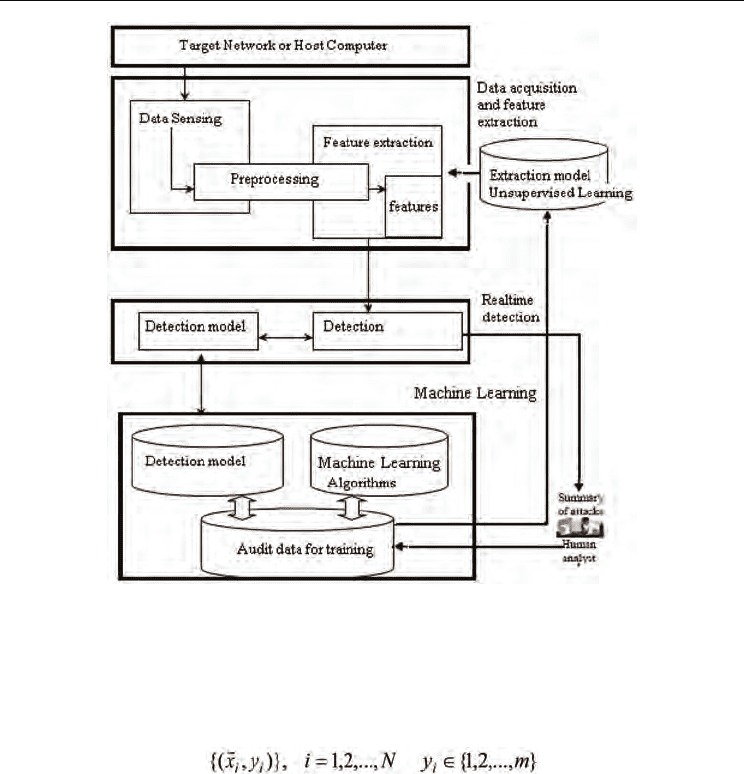
Machine Learning for Sequential Behavior Modeling and Prediction
405
Fig. 1. A framework for adaptive IDSs based on machine learning
2.2 Classifier construction
After performing feature extraction of network flow data, every network connection record
can be denoted by a numerical feature vector and a class label can be assigned to the record,
i.e.,
For the extracted features of audit data such as KDD99, when labels were assigned to each
data record, the classifier construction problem can be solved by applying various
supervised learning algorithms such as neural networks, decision trees, etc. However, the
classification precision of most existing methods needs to be improved further since it is
very difficult to detect lots of new attacks by only training on limited audit data. Using
anomaly detection strategy can detect novel attacks but the false alarm rate is usually very
high since to model normal patterns very well is also hard. Thus, the classifier construction in
IDSs remains another technical challenge for intrusion detection based on machine learning.
2.3 Sequential behavior prediction
As discussed above, host-based IDSs are different from network-based IDSs in that the
observed trajectories of processes or user shell commands in a host computer are sequential
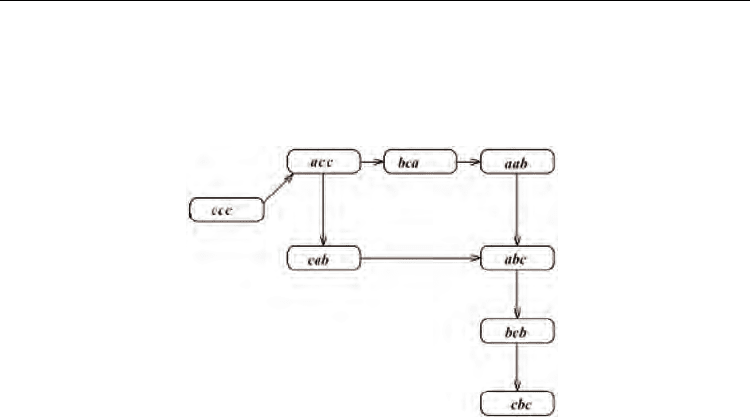
Machine Learning
406
patterns. For example, if we use system call traces as audit data, a trajectory of system calls
can be modeled as a state transition sequence of short sequences. In the following Fig. 2, it is
shown that every state is a short sequence of length 3 and different system call traces can
form different state transitions, where a, b, and c are symbols for system calls in a host
computer.
Fig. 2. A sequential state transition model for host-based IDSs
Therefore, the host-based intrusion detection problem can be considered as a sequential
prediction problem since it is hard to determine a single short sequence of system calls to be
normal and normal and there are intrinsic temporal relationships between sequences.
Although we can still transform the above problem to a static classification problem by
mapping the whole trace of a process to a feature vector [15], it has been shown that
dynamic behavior modeling methods, such as Hidden Markov Models (HMMs) [4], are
more suitable for this kind of intrusion detection problem. In the following, a host-based
intrusion detection method will be studied based on reinforcement learning, where a
Markov reward model is established for sequential pattern prediction and temporal
difference (TD) algorithms [16] are used to realize high-precision prediction without many
computational costs. At first, the popular HMMs for sequential behavior modeling will be
introduced in the next section.
3. Hidden Markov Models (HMMs) for sequential behavior modeling
Due to the large volumes of audit data, to establish and modify detection models manually
by human experts becomes more and more impractical. Therefore, machine learning and
data mining methods have been widely considered as important techniques for adaptive
intrusion detection, i.e., to construct and optimize detection models automatically. Previous
work using supervised learning mainly focused on static behavior modeling methods based
on pre-processed training data with class labels. However, training data labeling is one of
the most important and difficult tasks since it is hard to extract signatures precisely even for
known attacks and there are still increasing amounts of unknown attacks. In most of the
previous works using static behavior modeling and supervised learning algorithms, every
single sample of the training data was either labeled as normal or abnormal. However, the
distinctions between normal and abnormal behaviors are usually very vague and improper
labeling may limit or worsen the detection performance of supervised learning methods.
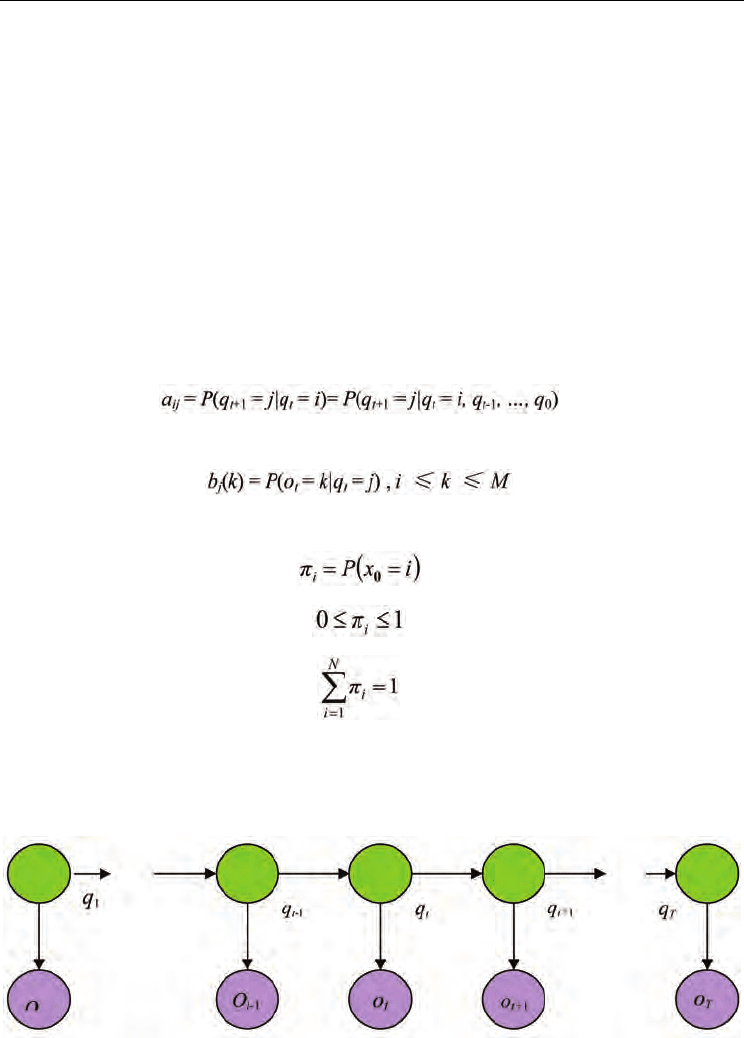
Machine Learning for Sequential Behavior Modeling and Prediction
407
More importantly, for complex multi-stage attacks, it is very difficult or even impossible for
static behavior models based on supervised learning to describe precisely the temporal
relationships between sequential patterns. The above problems become the main reasons
leading to the unsatisfactory performance of previous supervised learning approaches to
adaptive IDSs, especially for complex sequential data. The recent works on applying HMMs
[4] and other sequence learning methods [17] have been focused on dynamic behavior
modeling for IDSs, which tried to explicitly estimate the probabilistic transition model of
sequential patterns. For the purpose of comparisons, in the following, a brief introduction
on HMM-based methods for intrusion detection will be given.
As a popular sequential modeling approach, HMMs have been widely studied and applied
in lots of areas such as speech recognition [18], protein structure prediction, etc. A discrete
state, discrete time, first order hidden Markov model describes a stochastic, memory-less
process. A full HMM can be specified as a tuple: λ = (N, M, A, B, π), where N is the number
of states, M is the number of observable symbols, A is the state transition probability matrix
which satisfies the Markov property:
(1)
B is the observation probability distribution
(2)
and π is the initial state distribution. The initial state distribution π satisfies:
(3)
(4)
(5)
For discrete state HMMs, we can let Q = {q
1
, q
2
, …,q
M
} denote the set of all states, O = {O
1
, O
2
,
… ,O
N
} denote the set of all observation symbols. A typical trace of HMMs is shown in the
following Fig.3, where O
i
(i=1,2,…,T) are observation symbols and q
i
(i=1,2,…,T) are the
corresponding states.
Fig. 3. An HMM model

Machine Learning
408
In practice, there might be a priori reasons to assign certain values to each of the initial state
probabilities. For example, in some applications, one typically expects HMMs to start in a
particular state. Thus, one can assign probability one to that state and zero to others.
For HMMs, there are two important algorithms to compute the data likelihood when the
model of an HMM is given. One algorithm is the Forward-Backward algorithm which
calculates the incomplete data likelihood and the other is the Viterbi algorithm which
calculates the complete data likelihood. Implicitly, both Forward-Backward and Viterbi find
the most likely sequence of states, although differently defined. For detailed discussion on
the two algorithms, please refer to [8].
Another important problem in HMMs is the model learning problem which is to estimate
the model parameters when the model is unknown and only observation data can be
obtained. The model learning problem is essential for HMMs to be applied in intrusion
detection since a detection model must be constructed only by training data samples. For
model learning in HMMs, the Expectation-Maximization (EM) algorithm is the most
popular one which finds maximum a posteriori or maximum likelihood parameter estimate
from incomplete data. The Baum-Welch algorithm is a particular form of EM for maximum
likelihood parameter estimation in HMMs. For a detailed discussion on HMMs, the readers
may refer to [18].
In intrusion detection based on HMMs, the Baum-Welch algorithm can be used to establish
dynamic behavior models of normal data and after the learning process is completed, attack
behaviors can be identified as deviations from the normal behavior models.
4. Reinforcement learning for sequential behavior prediction
4.1 Intrusion detection using Markov reward model and temporal-difference learning
In HMM-based dynamic behavior modeling for intrusion detection, the probabilistic
transition model of the IDS problem is explicitly estimated, which is computationally
expensive when the number of states and the length of traces increase. In this Section, an
alternative approach to adaptive intrusion detection will be presented. In the alternative
approach, Markov state transition models are also employed but have an additional
evaluative reward function, which is used to indicate the possibility of anomaly. Therefore,
the intrusion detection problem can be tackled by learning prediction of value functions of a
Markov reward process, which have been widely studied in the reinforcement learning
community. To explain the principle of the RL-based approach to intrusion detection, the
sequential behavior modeling problem in host-based IDSs using sequences of system calls is
discussed in the following.
For host-based intrusion detection, the audit data are usually obtained by collecting the
execution trajectories of processes or user commands in a host computer. As discussed in
[19], host-based IDSs can be realized by observing sequences of system calls, which are
related to the operating systems in the host computer. The execution trajectories of different
processes form different traces of system calls. Each trace is defined as the list of system calls
issued by a single process from the beginning of its execution to the end. If a state at a time
step is defined as m successive system calls and a sliding window with length l is defined,
the traces of system calls can be transformed to a state transition sequences and different
traces correspond to different state transition sequences. For example, if we select a
sequence of 4 system calls as one state and the sliding length between sequences is 1, the
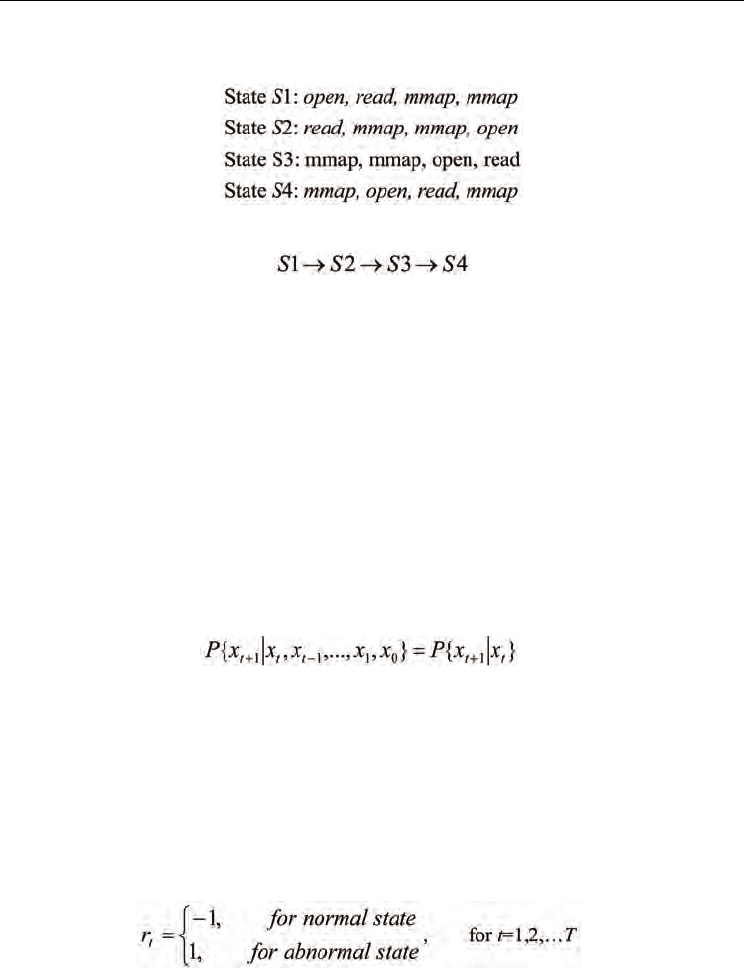
Machine Learning for Sequential Behavior Modeling and Prediction
409
state transitions corresponding to a short trace tr={ open, read, mmap, mmap, open, read,
mmap} are:
Then the state transition sequence of the above trace tr is:
As studied and verified in [4], dynamic behavior models for sequential pattern prediction
are superior to static models when temporal relationships between feature patterns need to
be described accurately. Different from the previous work in [4], where an HMM-based
dynamic behavior modeling approach was studied, the following dynamic behavior
modeling method for intrusion detection is based on learning prediction using Markov
reward models. The method is focused on a learning prediction approach, which has been
popularly studied in RL research [21-22], by introducing a Markov reward model of the IDS
problem so that high accuracy and low computational costs can both be guaranteed [20].
Firstly, the Markov reward model for the IDS problem is introduced as follows.
Markov reward processes are popular stochastic models for sequential modeling and
decision making. A Markov reward process can be denoted as a tuple {S, R, P}, where S is
the state space, R is the reward function, P is the state transition probability. Let
{x
t
|t=0,1,2,…; x
t
∈S} denote a trajectory generated by a Markov reward process. For each
state transition from x
t
to x
t+1
, a scalar reward r
t
is defined. The state transition probabilities
satisfy the following Markov property:
(6)
The reward function of the Markov reward plays an important role for dynamic behavior
modeling in intrusion detection problems. As described in the following Fig.2, in a Markov
reward model for intrusion detection based on system calls, each state is defined as a short
sequence of successive system calls and after each state transition, a scalar reward r
t
is given
to indicate whether there is a possibility to be normal or attack behaviors. The design of the
reward function can make use of available a priori information so that the anomaly
probability of a whole state trajectory can be estimated based on the accumulated reward
function. In one extreme case, we can indicate every state to be normal or abnormal with
high confidence and the immediate reward of each state is designed as
(7)
The above extreme case is identical to transform the dynamic behavior modeling problem to
a static pattern classification problem since we have class labels for every possible states,
where the reward becomes a class label for every state. However, in fact, due to the
sequential properties of system call data and the vague distinctions between normal traces
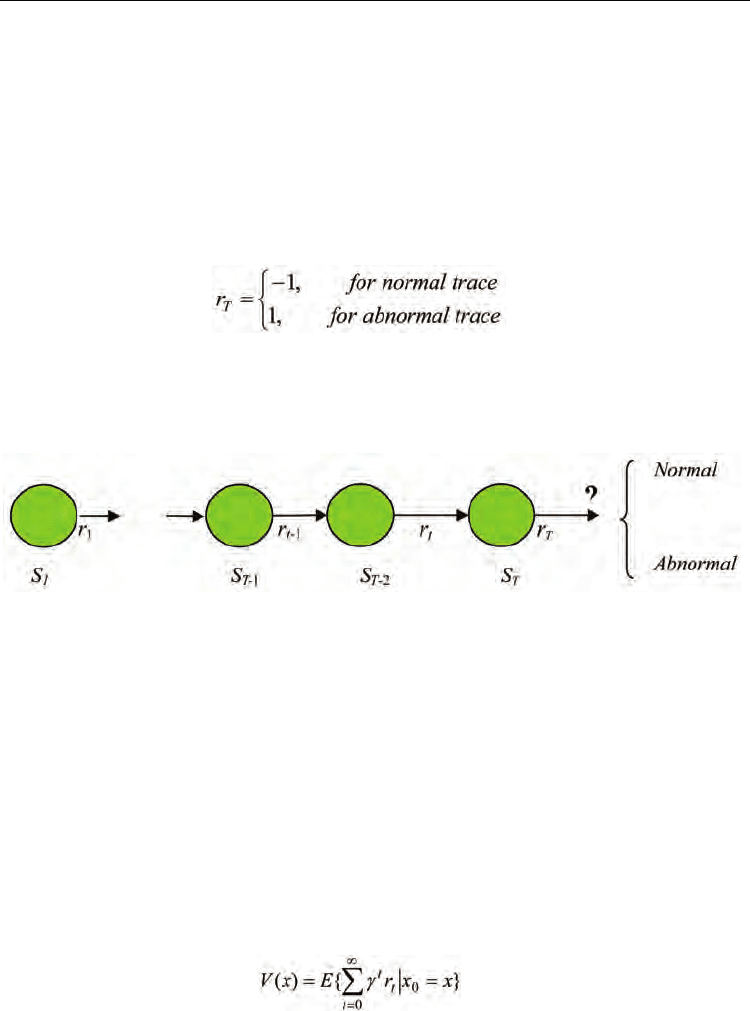
Machine Learning
410
and abnormal traces, it is usually not appropriate or even impossible to tell whether an
intermediate state to be normal or abnormal definitely. Moreover, even if it is reasonable to
assign precise class labels to every states, it is also very hard to obtain precise class labels for
large amounts of audit data. Therefore, it is more reasonable to develop dynamic behavior
modeling approaches which not only incorporate the temporal properties of state transitions
but also need little a priori knowledge for class labeling. An extreme case toward this
direction is to provide evaluative signals to a whole state transition trajectory, i.e., only a
whole state trajectory is indicated to be normal or abnormal while the intermediate states
are not definitely labeled. For example, in the following Fig.4, the reward at the terminal
state r
T
can be precisely given as:
(8)
For intermediate states s
1
,…, s
T-1
, a zero reward can be given to each state when there is no a
priori knowledge about the anomaly of the states. However, in more general cases, the
intermediate rewards can be designed based on available prior knowledge on some features
or signatures of known attacks.
Fig. 4. A Markov reward process for intrusion detection
According to the above Markov reward process model, the detection of attack behaviors can
be tackled by the sequential prediction of expected total rewards of a state in a trajectory
since the reward signals, especially the terminal reward at the end of the trajectory provide
information about whether the trajectory is normal or abnormal. Therefore, the intrusion
detection problem becomes a value function prediction problem of a Markov reward
process, which has been popularly studied by many researchers in the framework of
reinforcement learning [21-24]. Among the learning prediction methods studied in RL,
temporal difference learning (TD) is one of the most important one and in the following
discussions, we will focus on the TD learning prediction algorithm for intrusion detection.
Firstly, some basic definitions on value functions and dynamic programming are given as
follows.
In order to predict the expected total rewards received after a state trajectory starting from a
state x, the value function of state x is defined as follows:
(9)
where x ∈ S , 0 < γ ≤ 1 is the discount factor, r
t
is the reward received after state transition
x
t
→ x
t+1
and E{.} is the expectation over the state transition probabilities.
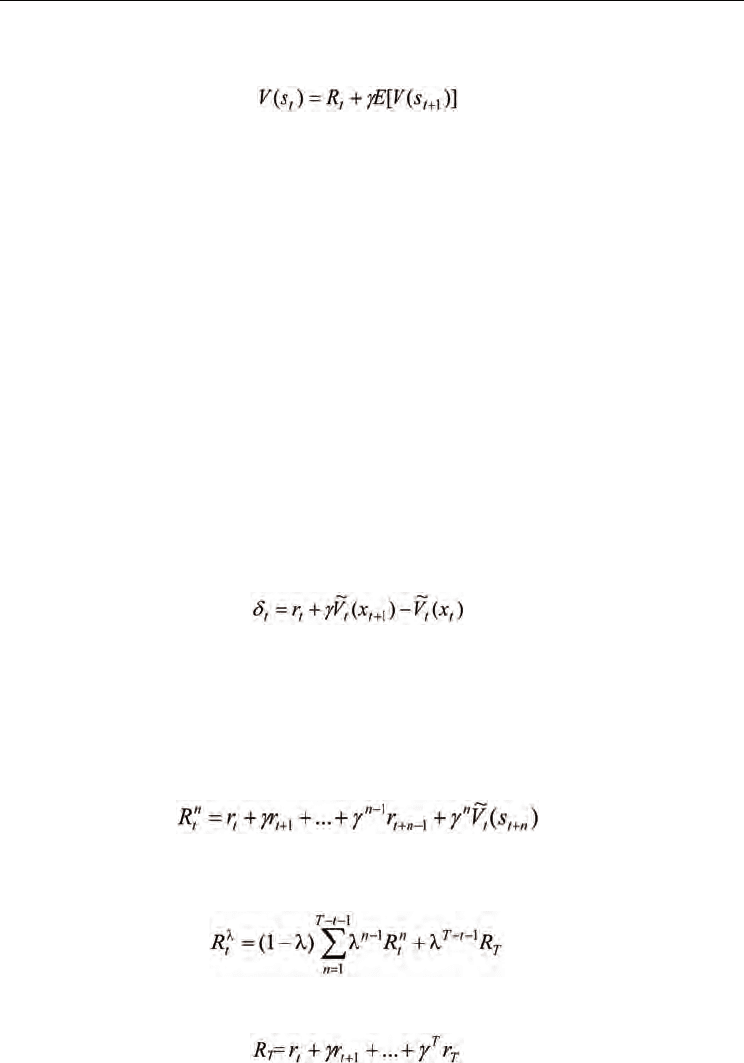
Machine Learning for Sequential Behavior Modeling and Prediction
411
According to the theory of dynamic programming, the above value function satisfies the
following Bellman equation.
(10)
where R
t
is the expected reward received after state transition x
t
→ x
t+1
.
The aim of RL is to approximate the optimal or near-optimal policies from its experiences
without knowing the parameters of this process. To estimate the optimal policy of an MDP,
RL algorithms usually predict the value functions by observing data from state transitions
and rewards. Thus, value function prediction of Markov reward models becomes a central
problem in RL since optimal policies or optimal value functions can be obtained based on
the estimation of value functions. However, in RL, learning prediction is more difficult that
in supervised learning. As pointed out by Sutton [22], the prediction problems in supervised
learning are single-step prediction problems while learning prediction in reinforcement
learning belongs to multi-step prediction, which is to predict outcomes that depend on a
future sequence of decisions.
Until now, temporal difference learning or TD learning has been considered as one of the
most efficient approaches to value function prediction without any a priori model
information about Markov reward processes. Different from supervised learning for
sequential prediction such as Monte Carlo estimation methods, TD learning is to update the
estimations based on the differences between two temporally successive estimations, which
constitutes the main ideas of a popular class of TD learning algorithms called TD( λ ) [22]. In
TD( λ ), there are two basic mechanisms which are the temporal difference and the eligibility
trace, respectively. Temporal differences are defined as the differences between two
successive estimations and have the following form
(11)
where x
t+1
is the successive state of x
t
, V
(x) denotes the estimate of value function V(x) and
r
t
is the reward received after the state transition from x
t
to x
t+1
.
As discussed in [22], the eligibility trace can be viewed as an algebraic trick to improve
learning efficiency without recording all the data of a multi-step prediction process. This
trick is originated from the idea of using a truncated reward sum of Markov reward
processes. In TD learning with eligibility traces, an n-step truncated return is defined as
(12)
For an absorbing Markov reward process whose length is T, the weighted average of
truncated returns is
(13)
where 0 ≤ λ ≤1 is a decaying factor and
(14)
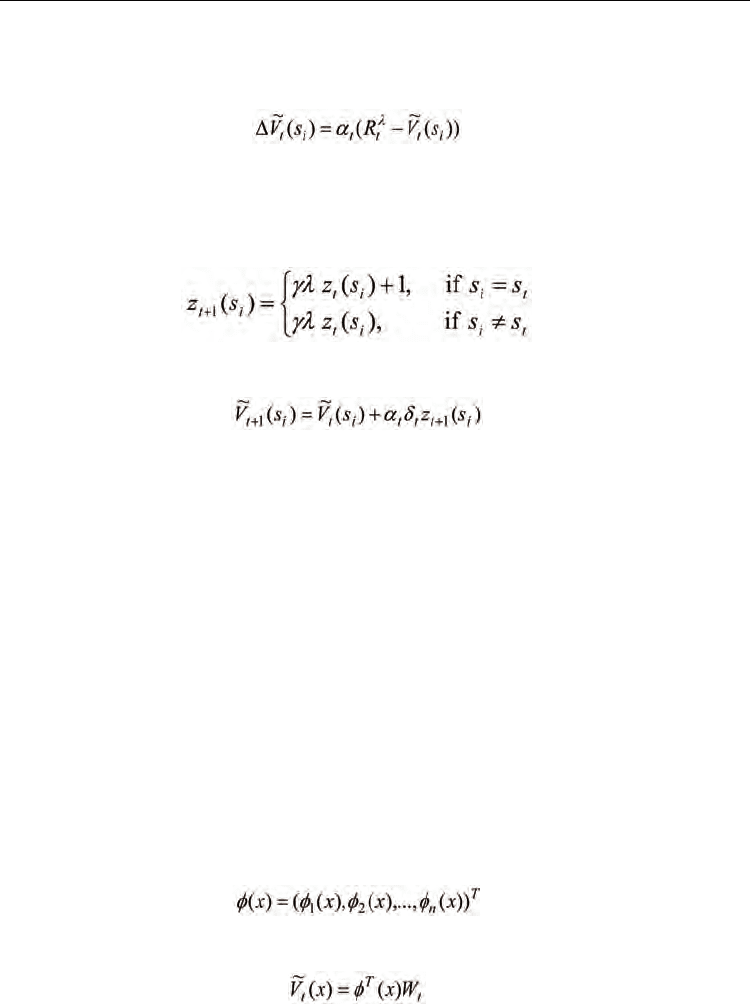
Machine Learning
412
R
T
is the Monte-Carlo return at the terminal state. In each step of TD( λ ), the update rule of
value function estimation is determined by the weighted average of truncated returns
defined above, i.e.,
(15)
where
α
t
is a learning factor.
The update equation (25) can be used only after the whole trajectory of the Markov reward
process is observed. To realize incremental or online learning, eligibility traces are defined
for each state as follows:
(16)
The online TD( λ ) update rule with eligibility traces is
(17)
where δ
t
is the temporal difference at time step t, which is defined in (21) and z
0
(s)=0 for all s.
Based on the above TD learning prediction principle, the intrusion detection problem can be
solved by a model learning process and an online detection process. In the model learning
process, the value functions are estimated based on the online TD( λ ) update rules and in
the detection process, the estimated value functions are used to determine whether a
sequence of states belongs to a normal trajectory or an abnormal trajectory. For the reward
function defined in (18), when an appropriate threshold μ is selected, the detection rules of
the IDS can be designed as follows:
If V (x) > μ , then raise alarms for attacks,
Else there are no alarms.
Since the state space of a Markov reward process is usually large or infinite in practice,
function approximators such as neural networks are commonly used to approximate the
value function. Among the existing TD learning prediction methods, TD( λ ) algorithms with
linear function approximators are the most popular and well-studied ones, which can be
called linear TD( λ ) algorithms.
In linear TD( λ ), consider a general linear function approximator with a fixed basis function
vector
(18)
The estimated value function can be denoted as
(19)
where W
t
=(w
1
, w
2
,…,w
n
)
T
is the weight vector.
The corresponding incremental weight update rule is
